Hydroxybiphenylamide GroEL/ES Inhibitors Are Potent Antibacterials against Planktonic and Biofilm Forms of Staphylococcus aureus
- PMID: 30392371
- PMCID: PMC6467803
- DOI: 10.1021/acs.jmedchem.8b01293
Hydroxybiphenylamide GroEL/ES Inhibitors Are Potent Antibacterials against Planktonic and Biofilm Forms of Staphylococcus aureus
Abstract
We recently reported the identification of a GroEL/ES inhibitor (1, N-(4-(benzo[ d]thiazol-2-ylthio)-3-chlorophenyl)-3,5-dibromo-2-hydroxybenzamide) that exhibited in vitro antibacterial effects against Staphylococcus aureus comparable to vancomycin, an antibiotic of last resort. To follow up, we have synthesized 43 compound 1 analogs to determine the most effective functional groups of the scaffold for inhibiting GroEL/ES and killing bacteria. Our results identified that the benzothiazole and hydroxyl groups are important for inhibiting GroEL/ES-mediated folding functions, with the hydroxyl essential for antibacterial effects. Several analogs exhibited >50-fold selectivity indices between antibacterial efficacy and cytotoxicity to human liver and kidney cells in cell culture. We found that MRSA was not able to easily generate acute resistance to lead inhibitors in a gain-of-resistance assay and that lead inhibitors were able to permeate through established S. aureus biofilms and maintain their bactericidal effects.
Figures
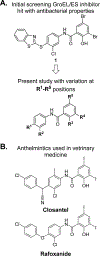
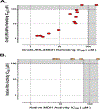
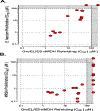
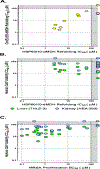

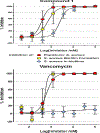

Similar articles
-
Analogs of nitrofuran antibiotics are potent GroEL/ES inhibitor pro-drugs.Bioorg Med Chem. 2020 Nov 15;28(22):115710. doi: 10.1016/j.bmc.2020.115710. Epub 2020 Aug 30. Bioorg Med Chem. 2020. PMID: 33007545 Free PMC article.
-
GroEL/ES inhibitors as potential antibiotics.Bioorg Med Chem Lett. 2016 Jul 1;26(13):3127-3134. doi: 10.1016/j.bmcl.2016.04.089. Epub 2016 May 4. Bioorg Med Chem Lett. 2016. PMID: 27184767
-
Sulfonamido-2-arylbenzoxazole GroEL/ES Inhibitors as Potent Antibacterials against Methicillin-Resistant Staphylococcus aureus (MRSA).J Med Chem. 2018 Aug 23;61(16):7345-7357. doi: 10.1021/acs.jmedchem.8b00989. Epub 2018 Aug 14. J Med Chem. 2018. PMID: 30060666 Free PMC article.
-
Combinations of maggot excretions/secretions and antibiotics are effective against Staphylococcus aureus biofilms and the bacteria derived therefrom.J Antimicrob Chemother. 2010 May;65(5):917-23. doi: 10.1093/jac/dkq042. Epub 2010 Feb 26. J Antimicrob Chemother. 2010. PMID: 20189943
-
Vision for medicine: Staphylococcus aureus biofilm war and unlocking key's for anti-biofilm drug development.Microb Pathog. 2018 Oct;123:339-347. doi: 10.1016/j.micpath.2018.07.002. Epub 2018 Jul 3. Microb Pathog. 2018. PMID: 30057355 Review.
Cited by
-
Tumescenamide C, a cyclic lipodepsipeptide from Streptomyces sp. KUSC_F05, exerts antimicrobial activity against the scab-forming actinomycete Streptomyces scabiei.J Antibiot (Tokyo). 2024 Jun;77(6):353-364. doi: 10.1038/s41429-024-00716-4. Epub 2024 Mar 25. J Antibiot (Tokyo). 2024. PMID: 38523145
-
Analogs of nitrofuran antibiotics are potent GroEL/ES inhibitor pro-drugs.Bioorg Med Chem. 2020 Nov 15;28(22):115710. doi: 10.1016/j.bmc.2020.115710. Epub 2020 Aug 30. Bioorg Med Chem. 2020. PMID: 33007545 Free PMC article.
-
Effect of Polyphenols on Inflammation Induced by Membrane Vesicles from Staphylococcus aureus.Cells. 2024 Feb 23;13(5):387. doi: 10.3390/cells13050387. Cells. 2024. PMID: 38474351 Free PMC article.
-
Exploring Novel Antibiotics by Targeting the GroEL/GroES Chaperonin System.ACS Pharmacol Transl Sci. 2024 Dec 11;8(1):10-20. doi: 10.1021/acsptsci.4c00397. eCollection 2025 Jan 10. ACS Pharmacol Transl Sci. 2024. PMID: 39816798 Review.
-
HSP60/10 chaperonin systems are inhibited by a variety of approved drugs, natural products, and known bioactive molecules.Bioorg Med Chem Lett. 2019 May 1;29(9):1106-1112. doi: 10.1016/j.bmcl.2019.02.028. Epub 2019 Feb 28. Bioorg Med Chem Lett. 2019. PMID: 30852084 Free PMC article.
References
-
- Centers for Disease Control and Prevention. Antibiotic resistance threats in the United States, 2013 Centers for Disease Control and Prevention: Atlanta, Georgia, USA, 2013; p 114.
-
- Boucher HW; Talbot GH; Bradley JS; Edwards JE; Gilbert D; Rice LB; Scheld M; Spellberg B; Bartlett J Bad bugs, no drugs: No ESKAPE! An update from the Infectious Diseases Society of America. Clin. Infect. Dis 2009, 48, 1–12. - PubMed
-
- Lewis K Platforms for antibiotic discovery. Nat. Rev. Drug Discov 2013, 12, 371–387. - PubMed
-
- Wright GD; Sutherland AD New strategies for combating multidrug-resistant bacteria. Trends Mol. Med 2007, 13, 260–267. - PubMed
-
- Bjarnsholt T The role of bacterial biofilms in chronic infections. APMIS Suppl 2013, 1–51. - PubMed
Publication types
MeSH terms
Substances
Grants and funding
LinkOut - more resources
Full Text Sources
Other Literature Sources
Chemical Information
Molecular Biology Databases
Research Materials

